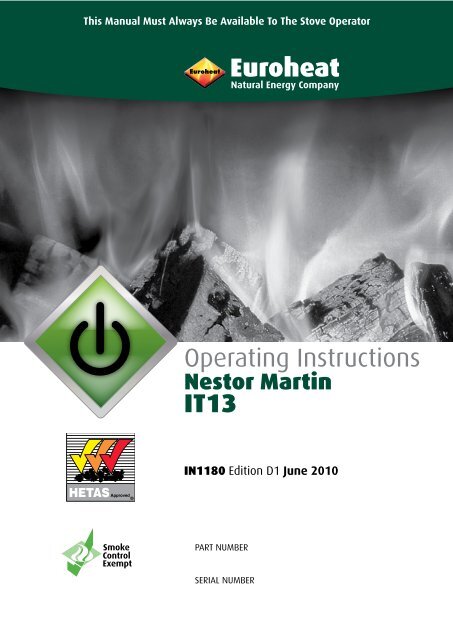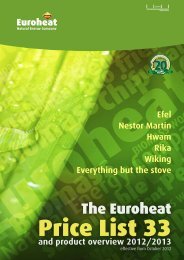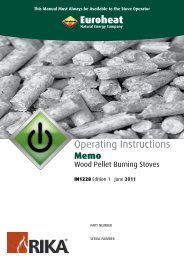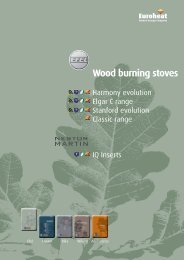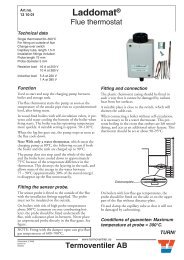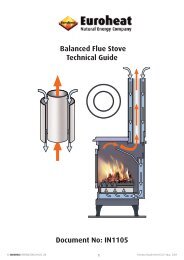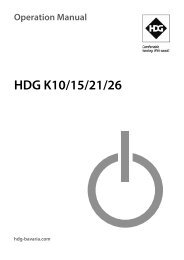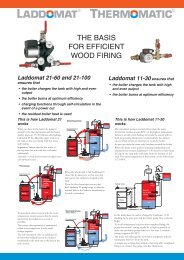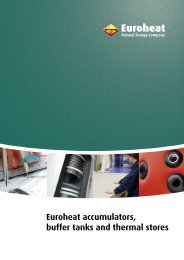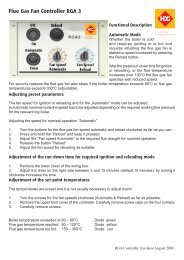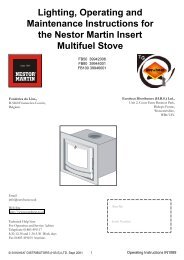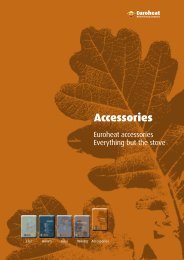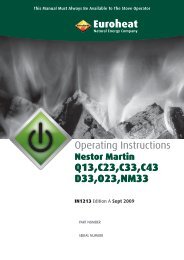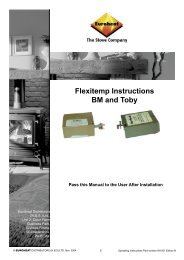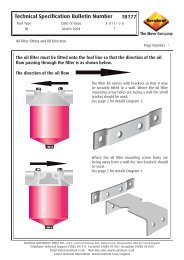IT13 Operation - Euroheat
IT13 Operation - Euroheat
IT13 Operation - Euroheat
Create successful ePaper yourself
Turn your PDF publications into a flip-book with our unique Google optimized e-Paper software.
This Manual Must Always Be Available To The Stove Operator<br />
Smoke<br />
Control<br />
Exempt<br />
PART NUMBER<br />
SERIAL NUMBER<br />
<strong>Euroheat</strong><br />
Natural Energy Company<br />
Operating Instructions<br />
Nestor Martin<br />
<strong>IT13</strong><br />
IN1180 Edition D1 June 2010
IMPORTANT<br />
The installation of this appliance must comply with all local regulations, including those referring to<br />
national and European Standards before it can be operated. The insert is not suitable for a shared flue.<br />
Improper adjustment, alteration, maintenance or the fitting of replacement parts not recommended by<br />
the manufacturer can cause injury or property damage. Do not operate the insert with faulty seals or<br />
damaged glass.<br />
Ensure all manuals are kept safely and are available for the user at all times.<br />
Do not store or use petrol or other flammable vapours and liquids in the vicinity of this or any other<br />
heating appliance. Do not burn anything but natural wood or approved coals on this appliance.<br />
Due to high operating temperatures of this appliance it should be located away from pedestrian traffic<br />
and away from furniture and draperies. Do not store paper or wood near the appliance. Any mats and<br />
rugs put in front of the insert should be fire proof and secured to prevent the possibility of tripping.<br />
Advise all persons as to the insert’s high surface temperatures, including visitors. If it is possible for<br />
children or infirm adults to come into contact with the insert, fit a suitable fire guard. Never let children<br />
“help” with the insert in any way, even when the insert is cold.<br />
It is imperative that all air passageways into, out of, and within the appliance are kept clean. All<br />
permanent ventilation into the room provided for the insert must remain clear and unobstructed at all<br />
times. Consideration must be given to the need for extra ventilation if another heating source needing<br />
air is to be operated simultaneously. If an extraction fan is proposed to be fitted to a connecting area of<br />
the house, after the insert has been installed, professional advice should sought from a qualified<br />
engineer.<br />
If a flue blockage or adverse weather conditions cause the insert to emit smoke, do not treat<br />
it as merely a nuisance, this smoke will indicate that carbon monoxide is being emitted into the room.<br />
Turn the insert to its minimum firing rate, open windows and allow the insert’s fuel to burn out before<br />
closing the windows. Do not re-light the insert without consulting a qualified engineer.<br />
In the event of a chimney fire the insert should be turned to its minimum setting and the fire brigade<br />
informed. Do not re-light the insert until the complete installation has been inspected by a qualified<br />
engineer.<br />
The appliance should be inspected regularly and the chimney cleaned at least annually. More frequent<br />
cleaning may be required and the advice of a qualified chimney sweep should be sought. Always check<br />
for any flue blockage before lighting the insert after a prolonged shut down.<br />
This insert has been carefully designed and constructed to give clean burning with optimum efficiency and safety,<br />
but as with all inserts these standards will not be achieved unless it is installed and maintained regularly by<br />
qualified engineers. It must also be operated strictly with the procedures given in this manual.<br />
If you are unsure about anything concerning your insert stove please seek professional advice.<br />
© EUROHEAT DISTRIBUTORS (H.B.S) LTD. June. 2010 2<br />
Instructions Part Number IN1180 Ed D1
Table of Contents<br />
The Model Explained .............................................................................................................................. 4<br />
Operating Items Supplied with the Stove ................................................................................................ 5<br />
Multifuel And Wood Inserts ..................................................................................................................... 6<br />
Choice of Fuels ......................................................................................................................................... 7<br />
Choice of Logs .......................................................................................................................................... 8<br />
The Plexus Air Control .............................................................................................................................. 9<br />
Air Direction Lever.................................................................................................................................... 9<br />
Air Volume Control ................................................................................................................................. 10<br />
Rotation Stop Button ............................................................................................................................. 11<br />
Minimum Air Setting .............................................................................................................................. 11<br />
Ash Collection ........................................................................................................................................ 12<br />
Available Accessories ............................................................................................................................. 12<br />
Ash Pan Removal ................................................................................................................................... 13<br />
Getting Started with Wood .................................................................................................................... 15<br />
Why Did You Fail? ................................................................................................................................... 18<br />
Advanced Driving With Wood ................................................................................................................. 19<br />
Slow, Overnight Burning ........................................................................................................................ 21<br />
Getting Started With Coal ...................................................................................................................... 22<br />
Lighting Coal With Firelighters .............................................................................................................. 24<br />
Advanced Insert Driving With Coal ........................................................................................................ 27<br />
Cleaning The Insert ................................................................................................................................ 28<br />
Simple Maintenance .............................................................................................................................. 28<br />
Removing The Chamber Baffle .............................................................................................................. 29<br />
Door Adjustment .................................................................................................................................... 30<br />
Technical Data, Intermittent <strong>Operation</strong> .................................................................................................. 31<br />
Technical data, Continuous <strong>Operation</strong> .................................................................................................... 31<br />
© EUROHEAT DISTRIBUTORS (H.B.S) LTD. June. 2010 3<br />
Instructions Part Number IN1180 Ed.D1
The Model Explained<br />
Thank you for purchasing your insert and helping to protect our environment. Nestor Martin and <strong>Euroheat</strong> insist<br />
on progressive development to produce products which are market leading. Our aims are to produce inserts with<br />
the latest innovations, user friendly operation and high efficiency for lower cost operation.<br />
This operation manual offers user information for the <strong>IT13</strong> Insert. The standard supply appliance is supplied with<br />
a Black four sided frame. An option of a nickel four sided frame is available.<br />
Model Identification<br />
You will see on the front page of this document a label which confirms which model you have. This label also<br />
advises you of the inserts unique serial number. This information is also attached to your insert for reference.<br />
Important<br />
Please ensure the warranty registration form is returned to <strong>Euroheat</strong>. In this way the model and its history will<br />
be record for reference in the future.<br />
Stoves supplied through <strong>Euroheat</strong> authorized retailers.<br />
For England, Wales, Scotland and Northern Ireland<br />
<strong>Euroheat</strong> Distributors (H.B.S). Ltd.<br />
Unit 2,<br />
www.euroheat.co.uk<br />
Court Farm Business Park,<br />
Bishops Frome,<br />
info@euroheat.co.uk<br />
Worcestershire. WR6 5AY.<br />
Whilst we are always happy to assist you, please make sure you have read this manual and have watched the<br />
Driving Your Stove DVD before requesting support.<br />
First contact your supplying retailer. If you find this not successful contact the <strong>Euroheat</strong> Technical Support Team.<br />
Technical support telephone Number 01885 491117. E-mail tech@euroheat.co.uk. Before telephoning ensure<br />
you have your stove’s serial number to hand. This can be found on the front of either the operating, installation,<br />
warranty registration, or on the stove identification label.<br />
<strong>Euroheat</strong> unfortunately are unable to offer support for appliances which were not supplied by <strong>Euroheat</strong>.<br />
Useful Organizations<br />
Stoves supplied through Eireheat authorized retailers.<br />
For Eire<br />
www.eireheat.com<br />
Sean Murphy Heating Ltd<br />
Kinvara<br />
Co Galway<br />
Eire<br />
sales@eireheat.com<br />
(091)637701 Fax: (091)637797<br />
International +353 91637701<br />
For support for appliances supplied through Eireheat in Ireland please contact using the<br />
details listed above.<br />
Thermic Distribution Europe Sa<br />
11 Rue De Lion<br />
B-5660<br />
Frasnes Les Couvin, Belgium.<br />
www.nestormartin.com<br />
Solid Fuel Association 0845 601 4406 www.solidfuel.co.uk<br />
The National Association of Chimney Sweeps 01785 811732 www.chimneyworks.co.uk<br />
HETAS Ltd. 0845 634 5626 www.hetas.co.uk<br />
© EUROHEAT DISTRIBUTORS (H.B.S) LTD. June. 2010 4<br />
Instructions Part Number IN1180 Ed D1
Operating Items Supplied with the Stove<br />
Heat Resistant Glove<br />
Please note that the die is not colour<br />
fast and if damp may leach out and be<br />
absorbed into porous surfaces.<br />
Operating Tool<br />
For Plexus Control operation<br />
and Ash Pan removal<br />
Instruction Manuals<br />
This Manual Must Always Be Available To The Stove Operator<br />
Smoke<br />
Control<br />
Exempt<br />
PART NUMBER<br />
<strong>Euroheat</strong><br />
Natural Energy Company<br />
Operating Instructions<br />
Nestor Martin<br />
<strong>IT13</strong><br />
IN1180 Edition D1 June 2010<br />
SERIAL NUMBER<br />
This Manual Must Always Be Available To The Stove Operator<br />
Smoke<br />
Control<br />
Exempt<br />
This manual must be used in<br />
conjunction with document IN1173.<br />
The Wood and Mutlifuel Chimney<br />
and Installation Guide.<br />
<strong>Euroheat</strong><br />
Natural Energy Company<br />
Installation &<br />
Servicing Instructions<br />
Nestor Martin<br />
<strong>IT13</strong><br />
IN1179 Edition E1 June 2010<br />
PART NUMBER<br />
SERIAL NUMBER<br />
DVD<br />
Universal User Guide for Wood<br />
and Multifuel Stoves. We strongly<br />
recommend all users watch this<br />
DVD<br />
Allen Key<br />
For Plexus maintenance<br />
Stove Registration<br />
Please complete the form on pages 3 and 4 and return it with a copy<br />
of your sales receipt for proof of purchase date from your <strong>Euroheat</strong><br />
approved supplier to obtain your<br />
Warranty<br />
Registration<br />
If any of the Instructions or the Warranty Registration form are missing please contact <strong>Euroheat</strong> quoting<br />
the stoves serial number and a replacement will be despatched immediately.<br />
© EUROHEAT DISTRIBUTORS (H.B.S) LTD. June. 2010 5<br />
Instructions Part Number IN1180 Ed.D1
Multifuel And Wood Inserts<br />
Gas and oil are consistent fuels and inserts can be designed to obtain the maximum heat from them with the<br />
user having to do no more than choose a heat setting. Solid fuels are almost infinitely variable and however well<br />
an insert has been designed, its performance will ultimately depend on the way the user operates it. Whilst we<br />
have endeavoured to make the insert as simple to operate as possible, understanding just a little about the fuels<br />
and the way your insert was designed to burn them will be rewarded by your being able to achieve the best from<br />
your insert with the least effort.<br />
As a fuel, wood is visually exciting, environmentally friendly, and a renewable source of energy but it is one of<br />
the most complex fuels to burn. Wood contains two sorts of components which burn. The fixed carbons which<br />
burn as the glowing embers, and the compounds that vaporize when heated to burn as volatile gasses, giving<br />
the endlessly changing flame patterns. The fixed carbon, which is charcoal, is a virtually trouble free fuel and<br />
needs little assistance to burn cleanly, but it would be difficult to describe it as visually entertaining.<br />
When set to its wood burning position, your insert heats the incoming air to ensure it has the minimum cooling<br />
effect on any volatiles. The air is supplied as slowly as possible so as not to blow out any established flames<br />
and it comes in across the full width of the insert ensuring that all parts of the insert receive an equal air supply.<br />
Because the air enters slowly over a curved blade the air is directed towards the burning volatiles rather than the<br />
bed of the fire, this allows the tar laden volatile components to use the incoming air as a priority. By placing a<br />
log or two towards the front of the fire whenever the flames from previous logs die down, a bed of charcoal will<br />
build up. This will be virtually pure carbon and capable of burning for incredibly long periods without causing any<br />
tar deposits on the insert’s glass even when the air supply is reduced to minimal setting.<br />
Always put logs on to the fire before flames from previous logs have extinguished, this will ensure that when the<br />
new logs begin releasing gasses it will ignite. Unburned gasses will cause smoke and tar deposits and wastes<br />
potential heat. Putting on too much wood at one time will both restrict the air supply and cool the combustion<br />
chamber making it more difficult for the gasses to burn cleanly.<br />
Never put on fresh wood whilst operating the insert with a minuscule air supply as a technique for operating<br />
for long periods without attention, it will cause both chilling and air restriction. Properly controlling the rate at<br />
which wood burns is not simply a matter of restricting the air supply, nor running the insert with a very small<br />
fire, it is maintaining the temperature and ignition flames in the insert whilst balancing the release of gasses to<br />
match the chosen air supply.<br />
No two woods have the same burning characteristics but all wood contains water. It is difficult to quantify the<br />
amount of water any log might hold whilst its exterior feels dry but it would not be unreasonable to estimate a<br />
mug full from a good sized, poorly seasoned, Imagine pouring that onto your fire every time you introduce a new<br />
log and you will realize its obvious effect of cooling the fire. What is not so obvious is that the moisture mixing<br />
with the vaporized gasses is cooling them, possibly below their ignition temperature. So the water within a wet<br />
log cooled the insert, it has prevented much of the potential heat from the log being realized and the unburned<br />
combustible products will be deposited as tars within the insert and flue. Advice on how to dry wood can be<br />
found on the DVD “User Guide” supplied with the insert.<br />
Coal suitable for inserts has only a very small proportion of components that vaporize and a far higher fixed<br />
carbon content and when the insert is set to its coal burning position air is supplied through the grate to the<br />
underside of the fire bed to supply the carbon directly. There will be sufficient spare air travelling through the<br />
fire bed to reach the limited gasses being released and this air will have been heated as it passed the burning<br />
coals.<br />
Because coals suitable for inserts have so little vaporizing content they are virtually trouble free fuels to use, but<br />
if you are using one of the manufactured smokeless coals take care to ensure the ash pan is checked regularly<br />
because some of them have a very high ash content; this is especially important if you change “brands” because<br />
the ash contents can vary dramatically. Always riddle the grate before putting on loadings of coal to give the<br />
initial release of gasses sufficient air with which to burn; failure to do so may allow the insert and flue to fill with<br />
gasses ready to ignite.<br />
© EUROHEAT DISTRIBUTORS (H.B.S) LTD. June. 2010 6<br />
Instructions Part Number IN1180 Ed D1
A insert is very much safer than an open fire, but if you have children or infirm people in the house please ensure<br />
it is suitably guarded, and consideration should also be given to accidental contact with the insert if you are<br />
entertaining with a busy house full of guests. If you have a remotely operated insert please ensure you keep the<br />
remote operating handset well away from the insert, children and dogs.<br />
Choice of Fuels<br />
Use of fuels in smoke exempt areas.<br />
If you are operating this stove within a smoke exempt area it is approved for use for the following fuels only:<br />
Seasoned dry wood. With a moisture content of 20% or less<br />
Smokeless coal approved for use in smoke exempt areas.<br />
Other fuels such as house coal, briquettes, waste wood, peat, wood over 20% moisture must not be used unless<br />
approved for use in smoke exempt areas.<br />
Wood<br />
All wood will burn slightly differently, but the most important differences between woods is their moisture<br />
content. Until the moisture has been driven off from the wood it will remain below its combustion temperature.<br />
When the outer skin has dried and beginning to burn, much of this heat energy will be wasted having to boil<br />
off the water remaining in the core of the wood. Copious amounts of water vapour, in all but the most insulated<br />
flue, will condense, and mix with the products of combustion to form creosote and other undesirable substances<br />
which will eat away the fabric of the flue, and eventually build up to block the flue. At any time this build up of<br />
tar will be capable of causing a chimney fire.<br />
The advice to burn only "dry" wood is sometimes confusing because the atmospheric moisture will prevent wood<br />
ever becoming "dry". It is acceptable to burn wood with a moisture content of less than 20%, which can be<br />
achieved by splitting the wood, stacking it so as to allow air to circulate within the stack and storing it under cover<br />
for between 18 months and 30 months, depending on prevailing climatic conditions. The use of a wood moisture<br />
content meter will confirm the amount of water remaining in the wood easily. The practice of drying wood by the<br />
insert should be discouraged, firstly because it should be unnecessary, and secondly because stored wood will<br />
invariably become the home to many varieties of insects, many of whom enjoy eating wood. To introduce them<br />
into your house and encourage them with heat and time to make new homes in your furniture and structural<br />
timbers is not recommended.<br />
Smokeless Coal<br />
We recommend burning deep mined anthracite, a natural hard coal which is classified as being a smokeless fuel;<br />
specifying the size of “large nuts” will give most visually attractive and efficient burning. Smaller sizes than<br />
this will tend to choke the air flow too easily making long burning times without attention problematic. Various<br />
manufactured smokeless coals are available giving differing burning characteristics and the manufacturers or<br />
your coal merchant will advise you as to their suitability for inserts. The difficulties and dangers associated with<br />
burning ordinary bituminous coal (house coal) with its relatively high volatile content make it totally unsuitable<br />
and potentially dangerous for burning in any insert.<br />
Lignite (also known as solid mineral fuel)<br />
Lignite is obtainable in briquette form and is best described as young coal. It behaves very much like coal and<br />
should be burned as smokeless manufactured coal. However it is not classified as smokeless and should not be<br />
used in smoke exempt area`s.<br />
Peat<br />
Peat burns very well, but it is bulky and its distinct aroma will pervade your home and everything in it, but<br />
otherwise peat can be burned as wood. However it is not classified as smokeless and should not be used in<br />
smoke exempt area`s.<br />
DO NOT BURN petroleum based fuels such as petro-coke, they may seriously damage your insert. The manufacturers<br />
of other blended coal products, containing a proportion of petro-coke, should be approached to confirm the<br />
suitability of the product for use within an enclosed appliance that does not have a chrome steel grate.<br />
© EUROHEAT DISTRIBUTORS (H.B.S) LTD. June. 2010 7<br />
Instructions Part Number IN1180 Ed.D1
Choice of Logs<br />
Never burn wood that is not dry or wood that has been subject to a manufacturing process, such as chipboard,<br />
as these contain resins of uncertain toxicity when burned. For the same reasons, wood that has been painted or<br />
treated with a preservative should never be burned.<br />
Natural wood is described as being either “hardwood” or “soft wood”. Typically all broad leaf trees that lose their<br />
leaves in the winter are called hard woods, and the evergreen conifers are called soft woods. Whilst the wood<br />
from the two groups have structural differences, the terms do not define the density or hardness of the wood.<br />
Balsa, one of the softest and lightest of woods is classified as being a hardwood and Hemlock, a soft wood, is<br />
extremely hard.<br />
The less density wood has, the more its structure is made up of open spaces meaning it will season faster and<br />
because of these voids it will burn faster because it will expose more surface area as it disintegrates. This makes<br />
light woods suitable for kindling or a rapidly developing fire but unless you enjoy putting wood onto a fire every<br />
few minutes it is unsuitable for burning over long periods. Although there is a difference in the speed at which<br />
woods burn, equal weights of wood will give very similar amounts of heat.<br />
Because logs are concentric tubes of cells they season faster if they are split, halving the tubes and allowing the<br />
moisture to evaporate more easily. Similarly it also allows the volatile gasses given off when the wood is heated<br />
in a insert to be emitted along its full length rather than at the log’s ends. This helps the gasses to be distributed<br />
more evenly within the insert and improves not only the efficiency, and emission reduction of wood burning but<br />
gives a more attractive fire.<br />
Putting logs onto the fire, bark side down and laying them, well spaced, in random orientation, rather than<br />
uniformly horizontally, will also help to increase the efficiency and attractiveness of the fire. To make this easier<br />
the ideal log length will be the length the insert’s combustion chamber can accommodate in all directions, and<br />
of proportionate cross-section, to allow you to load wood in a “higgledy-piggledy” manner.<br />
LOG SIZES. All logs should be split and ideally, quartered.<br />
Insert model Ideal Split Log Size Maximum Split Log Size<br />
IT 13 8 inches (200mm) Length 12 inches (300mm) Length<br />
3”x3” (75mm) Width 5”x5” (130mm) Width<br />
DO NOT BURN<br />
Anything but dry, natural wood. Wood that has been painted, treated or has hinges, nails or any plastic attached<br />
will almost certainly emit toxic matter when burned. For similar reasons bonded wood products such as chipboard,<br />
ply wood or fibre board must never be burned.<br />
DO NOT BURN<br />
Household waste. Many seemingly innocuous items like box packaging have been coated with glazes<br />
which will produce toxic matter when burned. One old video tape put on the fire will cause more<br />
pollution in a few minutes than a life time of wood burning. Not only will a fire burning rubbish pollute,<br />
the insert is not designed to contain such an assortment of sizes and weights and a flaming box falling<br />
from the insert when the door is opened will present an unacceptable fire hazard.<br />
© EUROHEAT DISTRIBUTORS (H.B.S) LTD. June. 2010 8<br />
Instructions Part Number IN1180 Ed D1
The Plexus Air Control<br />
Your insert is fitted with the plexus control panel shown below, allowing you to adjust both the air volume, by<br />
rotating the round knob and the direction from which air enters the insert, by moving the lever vertically up or<br />
down.<br />
Minimum Air<br />
Setting Lever<br />
Minimum<br />
Maximum<br />
LIGHTING AND MANUFACTURED<br />
SMOKELESS COALS<br />
ANTHRACITE WOOD<br />
This Lever May Be Hot. Always Use The Operating Tool To Make Air Direction Adjustments.<br />
Air Direction<br />
Lever<br />
Air Volume<br />
Control<br />
Rotation<br />
Stop Button<br />
Air Direction Lever<br />
When the direction lever is in its uppermost position the air enters the insert above the fire, and when set to its<br />
lower position air enters the insert from beneath the grate. Positioning the lever at its mid position will supply<br />
air both over and under the fire and this position is used when lighting a fire or burning manufactured smokeless<br />
coals. It should be set to its bottom position when burning natural smokeless coal such as anthracite and at its<br />
top position when burning wood.<br />
© EUROHEAT DISTRIBUTORS (H.B.S) LTD. June. 2010 9<br />
Instructions Part Number IN1180 Ed.D1
Air Volume Control<br />
The air volume should be set to maximum, 9 O’clock, only when lighting and the flue is cold. Settings giving<br />
normal operating temperatures will usually be between 12 O’clock and 3 O’clock, with slow burning being<br />
achieved when the control is set between 3 O’clock and 6 O’clock.<br />
Do not expect the insert’s performance to match any setting repeatedly because it will be affected by so many<br />
other factors such as fuel quality and weather conditions.<br />
Lighting and when<br />
the Flue is Cold Only<br />
Normal Operating<br />
Temperatures<br />
Slow Burning<br />
This Control Knob May be Hot. Always Use the Operating Tool to Make Air Volume Adjustments.<br />
© EUROHEAT DISTRIBUTORS (H.B.S) LTD. June. 2010 10<br />
Instructions Part Number IN1180 Ed D1
Rotation Stop Button<br />
To enable the Air Volume Control knob to be rotated to the lighting position press rotation stop button inwards<br />
while rotating the Air Volume Knob.<br />
This auto stop system prevents the user leaving the control in an over air condition which severally reduces<br />
the appliances efficiency. This stop also prevents the remote control when in automatic mode increasing the<br />
combustion air beyond ideal operational conditions.<br />
Minimum<br />
Maximum<br />
Minimum Air Setting<br />
This facility of having an adjustable minimum<br />
air setting provides a positive repeatable Minimum<br />
air setting that will give the lowest burning<br />
rate at which the stove will continue burning<br />
when the firing rate control is turned to its<br />
minimum position. It will also give a small Maximum<br />
feed to the air wash when the stove is<br />
burning coal, not enough to risk damage to<br />
the grate, but enough to help keep the glass<br />
clean. It is also an important safety feature. If<br />
the stove has been burning with a constant air<br />
supply it has been generating and burning the<br />
volatile gasses from the fuel. If the air supply<br />
is abruptly and completely removed the fire will extinguish but the release of gasses will continue for some time.<br />
These gases will be above their ignition temperature and be potentially explosive if they come into contact with<br />
air. The constant air bleed that the small flap allows will keep some of these gasses burning and prevent sudden<br />
ignition whilst the generation of gasses reduces.<br />
Important<br />
If the appliance is to used with wood in a smoke exempt area the minimum air control<br />
flap must be set at its maximum position. This flap should only be adjusted by approved<br />
engineers. See Installation instructions for more details.<br />
Smoke<br />
Control<br />
Exempt<br />
This lever should be set to maximum (fully open) at all times unless advised otherwise by<br />
your heating engineer or the <strong>Euroheat</strong> Technical Department.<br />
© EUROHEAT DISTRIBUTORS (H.B.S) LTD. June. 2010 11<br />
Instructions Part Number IN1180 Ed.D1
Ash Collection<br />
The grate can be riddled to encourage ash to fall into the ash pan by locating the right angled end of the operating<br />
tool into the riddling actuating rod and using a push pull action to cause the grate to oscillate. The riddling rod is<br />
located between the Plexus facia panel and the ash pit door.<br />
As well as being used to rearrange the fire bed, the poker is designed to be<br />
used for clearing ash through the grate slots and this will be found to be the<br />
most effective way of clearing wood ash when the fire has burned out. If<br />
the fire has been running on anthracite coal, and the insert has been over<br />
filled and under riddled, the poker may have to be used to clear the grate<br />
of ash and partially burned coals.<br />
Important.<br />
If it becomes necessary to riddle the<br />
insert while it is operating, always riddle<br />
the insert before adding new fuel.<br />
Do not allow the ash pan to over fill. This will cause ash to fall behind the ash pan as it is removed<br />
and can prevent the ash pan from fitting correctly. Over filling the ash pan can prevent under<br />
grate air reaching the fire which can cause poor operation and damage to the grate.<br />
Available Accessories<br />
<strong>Euroheat</strong> offer a range of accessory items which may assist with your day to day operation. These<br />
include fire tool sets for cleaner operation, log stores for storing wood and other items. Ask your<br />
euroheat retailer for the “EveryThing but the Stove Brochure” or visit the <strong>Euroheat</strong> web site.<br />
www.euroheat.co.uk<br />
© EUROHEAT DISTRIBUTORS (H.B.S) LTD. June. 2010 12<br />
Instructions Part Number IN1180 Ed D1
Ash Pan Removal<br />
Your ash pit door will be one of two designs, with the rope sealed door having a lever locking mechanism and<br />
the silicon sealed door which has only the hexagon key slot visible.<br />
The operating tool right angle end is used to engage the ash pan socket. Care should be taken to ensure the<br />
tool is fully engaged before removing the ash pan. The glove should always be worn so that the ash pan can be<br />
securely held. Do not put the ash into, or with, anything combustible; even seemingly cold ashes may contain<br />
small glowing embers capable of igniting items they come in contact with.<br />
© EUROHEAT DISTRIBUTORS (H.B.S) LTD. June. 2010 13<br />
Instructions Part Number IN1180 Ed.D1
The ash pit door should be closed before lighting a fire in the insert and it should remain closed whilst the insert<br />
is operating. Opening the ash pit door when the insert is operating may cause flames to be directed fiercely at<br />
the glass and the intense heat will turn the areas of glass hit by the flames, irrevocably, opaquely white.<br />
The insert is capable of continuous operation and if it is being operated continuously it will therefore be necessary<br />
to empty the ash pan whilst the insert has a burning fire. If the ash pit door is to be opened and the ash pan<br />
removed safely the following procedure should be followed.<br />
Allow the fire to burn down as low as practicable and check that no embers will fall from the insert when the<br />
door is opened. Wearing the glove and using the operating tool partially open the main front door. This will let<br />
air into the insert above the fire and limit air being drawn in through the grate but prevent smoke from spilling<br />
into the room.<br />
ACME ACME<br />
The ash pit door can now be opened and the ash pan removed. The ash pit door must be closed immediately<br />
the ash pan is removed and the insert door must also be closed securely. When re-installing the empty ash pan<br />
the insert door must again be slightly opened before opening the ash pit door. Never open the ash pit door<br />
without the insert door being ajar and never leave either the insert door or the ash pit door open for longer than<br />
absolutely necessary.<br />
Preparation must be made for the safe handling and disposal of the burning embers in the ash pan before<br />
beginning this operation. Good practice would be to have an empty metal container brought to the insert so the<br />
ash pan can be emptied directly into it.<br />
Never leave the insert unattended without both its doors being securely closed.<br />
Always check, meticulously, that no embers have been spilled whenever any insert door has been opened.<br />
Always use gloves when carrying the ash pan, even when you think the ash is cold.<br />
Do not empty ash into a plastic waste bin or any bin containing combustible waste.<br />
There will be hot embers in the insert, long, even days, after the fire appeared to extinguish. Never clean out<br />
ashes onto paper, never use a plastic bristled brush or a vacuum cleaner to remove ash.<br />
Never let children “help” with the insert in any way,<br />
© EUROHEAT DISTRIBUTORS (H.B.S) LTD. June. 2010 14<br />
Instructions Part Number IN1180 Ed D1
Getting Started with Wood<br />
Ensure the ash pan is fitted and empty,<br />
then securely close the ash pit door.<br />
Lightly crumple two tabloid sized pieces of<br />
newspaper and lay them in the middle of the<br />
grate.<br />
Resist the temptation to use more paper than<br />
this, or to crumple it too tightly; doing either<br />
will prevent the rapid development of flames<br />
and will cause smoke to be produced.<br />
Having learned where to find the controls, you are now ready to light a wood<br />
fire in the insert, without filling the insert or neighbourhood with smoke.<br />
You will need two pieces of newspaper, a small bundle of kindling wood and<br />
several split logs. All of these should be as dry as possible; never use wet<br />
wood, it will cause smoke, deposit tar in the insert and flue to become a<br />
potential fire hazard.<br />
Remember that your insert needs the help of a gentle push start in the right<br />
direction until it warms. Do not expect it to be on auto pilot until it reaches its<br />
operating temperature.<br />
© EUROHEAT DISTRIBUTORS (H.B.S) LTD. June. 2010 15<br />
Instructions Part Number IN1180 Ed.D1<br />
ACME<br />
Set the Plexus control to maximum air volume and the air direction<br />
lever to mid position, supplying air above and below the grate.
As the cone of kindling burns it will collapse and the inner<br />
ends of the wood will begin to char and glow.<br />
Wait until a substantial amount of the kindling is charring<br />
before moving onto the next stage.<br />
Move the air direction lever to its uppermost position and do not<br />
be alarmed if the fire appears die, or be tempted to move it back<br />
to its middle position.<br />
The kindling wood should be placed over the paper so as to rest<br />
against each other in a conical formation, leaving space between<br />
each piece.<br />
Light the paper using a long match or spill and close the insert<br />
door.<br />
The lightly crumpled paper will begin burning rapidly and the<br />
space between the kindling will allow the long bright flames<br />
to pass between and over the wood raising it to its ignition<br />
temperature.<br />
Wearing the glove place a log to either side of the burning<br />
kindling and larger than kindling wood over, but not smothering,<br />
the kindling.<br />
© EUROHEAT DISTRIBUTORS (H.B.S) LTD. June. 2010 16<br />
Instructions Part Number IN1180 Ed D1
Reduce the air volume control when the fire is established.<br />
Never leave it in its lighting position continuously.<br />
If you lit your fire in the insert cleanly and you are now feeling<br />
it becoming hot, congratulations, you have passed the lighting<br />
test and are no longer a total novice. You can throw away<br />
your “L” plates and move on to become an advanced driver.<br />
See page 19.<br />
When the previous loading of wood is burning brightly<br />
add another log to bridge the fire. Always avoid<br />
putting wood directly onto wood burning with flame<br />
because the new, cold, log will tend to cool the flame<br />
giving gasses below their ignition temperature.<br />
Conversely, you should try and position new logs<br />
directly onto glowing embers.<br />
Putting new logs, bark side down, towards the<br />
front of the grate will give you both maximum<br />
efficiency and best visual effect as it begins to<br />
burn.<br />
Never put more than a layer of wood on at a time<br />
as the logs will become unstable and may roll<br />
against the glass, making it difficult to open the<br />
door.<br />
© EUROHEAT DISTRIBUTORS (H.B.S) LTD. June. 2010 17<br />
Instructions Part Number IN1180 Ed.D1
Why Did You Fail?<br />
Not everyone will pass with flying colours at the first attempt, indeed even some<br />
experienced insert users will fail their test because producing smoke and tar was<br />
historically acceptable.<br />
Before checking your technique, make absolutely certain that the wood you are using is<br />
dry, not “seasoned”, “barn stored” or “ready for burning”. It must be dry if you want to<br />
burn it successfully, cleanly and efficiently. (See the <strong>Euroheat</strong> document Number IN1172<br />
for further information.)<br />
The Fire Went Out<br />
Do not put wood onto the kindling too soon or without allowing vents for the flames. The quality of the wood<br />
will determine how much fuel can be loaded at one time but remember you are lighting the insert and wanting<br />
it to reach its operating temperature as quickly as possible; all smoke is a pollutant and wasted fuel.<br />
The Glass Blackened<br />
See the above. The fire may not have extinguished, but smoke and staining are unburned fuel gasses from the<br />
wood. Until the flue has warmed, air supply to the insert will be limited and only allow the complete combustion<br />
of limited amounts of wood. Too much wood, too soon, will only serve to cool the gasses below their ignition<br />
temperature.<br />
© EUROHEAT DISTRIBUTORS (H.B.S) LTD. June. 2010 18<br />
Instructions Part Number IN1180 Ed D1<br />
X<br />
X<br />
X X<br />
THE FIRE NEVER DEVELOPED ENOUGH SIZE OR BECAME HOT ENOUGH<br />
Once the fire is well alight the air volume must be reduced from its maximum<br />
position. Leaving it at maximum will allow too much air into the insert. Air which<br />
is not needed will only serve to cool the insert, air travelling too quickly will blow<br />
some of the flames out.
Advanced Driving With Wood<br />
Once the insert is at its operating temperature it is capable of burning cleanly<br />
and efficiently with little or no intervention from you beyond periodic loading<br />
of wood.<br />
Two reasons for a insert failing to operate cleanly and efficiently make all other<br />
reasons virtually insignificant. One is the use of wet wood, which should never<br />
be used, and the other, which we will be discussing now, is the inappropriate<br />
intervention by an operator failing to understand a few simple principles.<br />
When to Put on More Wood<br />
When the fire in the insert has become established you will find that the insert seems, initially, to consume wood<br />
quite quickly. This is because the insert was designed to burn off the wood’s volatile matter first, leaving the<br />
charcoal to form a hot bed above the grate. The charcoal helps maintain a constant heat output from the insert<br />
between loading of wood and aids the rapid ignition of new loading, thus minimizing smoke emissions. The<br />
depth to which the charcoal should be let to accumulate will depend upon the length of time you are expecting<br />
to operate the insert for and the heat output you need. Never load more wood than can be contained safely by<br />
the log guard.<br />
Putting new wood on immediately the flames of the previous loading have almost extinguished will result in a<br />
very hot insert with a deep charcoal bed capable of being controlled to burn very slowly, without staining the<br />
glass, for many hours. If only a low heat output or limited burning time is required the charcoal will be producing<br />
much of the heat with an occasional log being loaded for interest. Letting the bed become too small, or putting<br />
on a new log when all the flames from a previous loading have extinguished will cause smoke as the new loading<br />
struggles to ignite. Always add wood to the insert before flames from a previous loading have extinguished. If<br />
there are no flames, only glowing embers, add a small amount of kindling wood and set the insert to its ignition<br />
setting. Never put logs onto a fire without flames, they will smoulder and emit smoke.<br />
X<br />
How to Put on More Wood<br />
Wood needs not only heat but also air to burn and putting an enormous amount of logs at one time or interlocking<br />
them like bricks will both stifle the existing fire, causing it to cool; it will also limit the air available for the new<br />
wood. This will result in delayed ignition of the loading and unacceptable levels of smoke emission.<br />
Always try to keep ends of logs away from the combustion chamber walls so that gasses emanating will have<br />
good access to air. If you are having to burn unsplit logs, they will release most of their initial gasses only from<br />
their ends, it is important to rake embers so that the log ends are over the charcoal bed to heat the gasses to<br />
promote rapid ignition. Avoid burning un-split logs if you can. If the logs are split it is better to put the log on the<br />
fire bark side down because the bark will ignite rapidly when placed on the charcoal and gasses from the split<br />
surfaces will have an unrestricted air supply.<br />
© EUROHEAT DISTRIBUTORS (H.B.S) LTD. June. 2010 19<br />
Instructions Part Number IN1180 Ed.D1<br />
X
Always try to position new logs so that they are in the path of existing flames by bridging the flames where<br />
possible. Do not over fill the insert with wood expecting it to burn for an extended time, it will produce little but<br />
smoke and tar. If the insert is running with a low air volume setting, turning up the volume for a few minutes<br />
whenever you load new logs will encourage them to ignite faster. Do not be afraid to put logs towards the front<br />
of the fire, the glass will stay clean and the visual interest will be increased.<br />
LOG ENDS TOO CLOSE<br />
TO INSERT WALLS.<br />
NO SPACE BETWEEN THE<br />
LOGS<br />
Setting the Burning Rate<br />
X X<br />
TOO MANY LOGS<br />
TOO LITTLE SPACE BETWEEN<br />
THE LOGS.<br />
Setting the air volume rate on the Plexus should always be done with reference<br />
to the condition of the fire. You cannot expect to turn the air to maximum and<br />
the insert increase its heat output if the fire in the insert is ash with a few<br />
glowing embers. Neither should the insert be expected to shut down a huge fire<br />
immediately the air supply was restricted, without producing copious amounts<br />
of smoke. Unlike driving a car that accelerates and brakes, wood burning should<br />
be regarded as something that gathers and losses momentum gracefully, and<br />
all adjustments to the burning rate should be made accordingly.<br />
Putting a large quantity of wood into the insert and turning the air setting to<br />
low will inevitably result in smoke as the wood is heated with insufficient air<br />
to burn with. Always wait until the wood is producing flames before turning<br />
down the air volume in stages. If the fire has become very lethargic after a long<br />
period of slow burning, or has no flames, set the air controls to their lighting<br />
position and place a few pieces of dry kindling onto the fire bed to ensure rapid<br />
ignition. Once the kindling has ignited the air direction lever should be set to<br />
its uppermost position and the volume control set to the 12 O’clock position<br />
before adding one or two logs. Never allow wood to smoulder, it wastes heat<br />
and pollutes the atmosphere.<br />
If you have fitted a remotely controlled burner rate<br />
adjustment, please read instruction Guide supplied<br />
with the remote control.<br />
CORRECTLY LOADED<br />
© EUROHEAT DISTRIBUTORS (H.B.S) LTD. June. 2010 20<br />
Instructions Part Number IN1180 Ed D1<br />
+
Slow, Overnight Burning<br />
Wood releases its volatile gasses when heated, if insufficient air is available,<br />
or the temperature is below the ignition temperature of these gasses,<br />
they will deposit themselves as tar and other undesirable substances on<br />
the insert body, glass and in the flue. Filling the insert with wood and<br />
restricting the air supply may be the only option available to many who<br />
want to keep the insert warm for extended periods but it is not necessary<br />
for you to adopt this ant-social practice.<br />
Your insert has been designed to burn all the gasses from the wood as a<br />
priority, leaving the charcoal to burn later. Good quality charcoal, which<br />
is what the insert will produce, has the ability to burn slowly and cleanly<br />
with a restricted air supply, and by allowing the charcoal to build up in<br />
the insert it will provide many hours of clean gentle heat. The amount of<br />
charcoal needed to burn for any length of time is surprisingly small but the<br />
quantities can be increased by putting new loading of wood to the front of the insert.<br />
Of great importance is that the insert’s air is not reduced to a very low setting if flames are still visible; reducing<br />
the air to a minimum will extinguish any flames and cause tar and smoke to be produced. Always wait until no<br />
more flames are evident before you can safely turn the air volume to a minimum setting with no fear of staining<br />
the glass. The actual setting needed will depend upon the performance of your flue setting, and by raking the<br />
ashes through the grate in the morning will reveal either no charcoal remains which means the setting was too<br />
high, or a cold insert and an abundance of charcoal indicating the setting was too low. If any charcoal remains<br />
never assume it not to be burning. If you rake any charcoal over the grate, close the insert door and set the<br />
air controls to their lighting position it will almost always begin to glow even when it gave no sign of burning.<br />
Placing wood, whose size is in proportion to the amount of charcoal remaining, over the burning charcoal will<br />
rapidly produce a good fire because the insert and flue will have retained some residual heat. This technique of<br />
using only the charcoal to burn should be used whenever the insert is to be left unattended for long periods.<br />
If you have managed to run your insert overnight, without staining the glass, you have achieved the highest<br />
achievement possible as a insert operator and you should award yourself an enormous gold star.<br />
© EUROHEAT DISTRIBUTORS (H.B.S) LTD. June. 2010 21<br />
Instructions Part Number IN1180 Ed.D1
Getting Started With Coal<br />
(Solid mineral fuel)<br />
Having learned where to find the controls, you are now ready to light<br />
a coal fire in the insert, without filling the insert or neighbourhood<br />
with smoke. To light the fire with wood you will need two pieces of<br />
newspaper, a small bundle of kindling wood, and smokeless coal.<br />
Remember that your insert needs your help to gently push start it in the<br />
right direction until it warms. Do not expect it to be on auto pilot until it<br />
reaches its operating temperature.<br />
ACME<br />
If the fire is to be lit using paper and wood, set the Plexus control<br />
to maximum air volume and the air direction lever to mid position,<br />
supplying air above and below the grate.<br />
Ensure the ash pan is fitted and empty,<br />
then securely close the ash pit door.<br />
Lightly crumple two tabloid sized pieces of newspaper and<br />
lay them in the middle of the grate.<br />
Resist the temptation to use more paper than this, or<br />
to crumple it too tightly; doing either will prevent the<br />
rapid development of flames and will cause smoke to be<br />
produced.<br />
© EUROHEAT DISTRIBUTORS (H.B.S) LTD. June. 2010 22<br />
Instructions Part Number IN1180 Ed D1
Wait until the kindling fire core has lost its large flames and<br />
is glowing then, wearing the glove, lay several pieces of<br />
kindling on the top of them followed by pieces of coal.<br />
The kindling wood should be placed over the paper so as to rest<br />
against each other in a conical formation, leaving space between<br />
each piece.<br />
Light the paper using a long match or spill and close the insert<br />
door.<br />
The lightly crumpled paper will begin burning rapidly and the space<br />
between the kindling will allow the long bright flames to pass<br />
between and over the wood raising it to its ignition temperature.<br />
Try to leave open spaces between pieces of coal with some bridging<br />
others rather than a single layer. Putting on too much at this stage<br />
will only cause smoke and hinder the fire’s development.<br />
When the loading of coal is burning brightly, the air volume should be reduced and set to the 12 O’clock<br />
position.<br />
If you are burning one of the manufactured smokeless coals the air direction lever should always remain in the<br />
mid position.<br />
If you are burning Anthracite, the air direction lever should now be moved to the lowest position.<br />
© EUROHEAT DISTRIBUTORS (H.B.S) LTD. June. 2010 23<br />
Instructions Part Number IN1180 Ed.D1
Lighting Coal With Firelighters<br />
Placing a layer of coal on the grate for the firelighters to sit<br />
on will help to defuse the air flow.<br />
New loading of coal should be placed to cover only coals which<br />
are glowing. It will delay the ignition of coal not already burning<br />
if further layers of coal are added to them. Smoke production will<br />
be reduced if new coals are added only when the coal has stopped<br />
emitting flames but is glowing brightly.<br />
Fire lighters perform well only if the blocks are protected from fast air<br />
flow. Setting the air volume to a position between 12 O’clock and 3<br />
O’clock will provide sufficient air for the firelighters to burn without<br />
causing the flames to be blown out. The air direction lever should be set<br />
to its mid position.<br />
Bridge the firelighters with coal trying to avoid coal actually<br />
touching the firelighters.<br />
© EUROHEAT DISTRIBUTORS (H.B.S) LTD. June. 2010 24<br />
Instructions Part Number IN1180 Ed D1
The coal should be at least glowing by the time the firelighters have<br />
extinguished and may even be producing flames.<br />
If the fuel is manufactured smokeless coal the air direction lever should remain in the mid position. If the fuel is<br />
anthracite the lever should be set to its lowest position. Whichever coal is being used the air volume should now<br />
be set to the 12’O clock position.<br />
If you lit your fire in the insert cleanly and you are now feeling<br />
it becoming hot, congratulations, you have passed the lighting<br />
test and are no longer a total novice, You can throw away your<br />
“L” plates and move on to become an advanced driver.<br />
See page 25<br />
New loading of coal should be placed to cover only coals which<br />
are glowing. It will delay the ignition of coal not already burning<br />
if further layers of coal are added to them. Smoke production will<br />
be reduced if new coals are added only when the coal has stopped<br />
emitting flames but is glowing brightly.<br />
© EUROHEAT DISTRIBUTORS (H.B.S) LTD. June. 2010 25<br />
Instructions Part Number IN1180 Ed.D1
Why Did You Fail?<br />
Coal is generally a simple, trouble free fuel which lights easily, but slowly. Before looking<br />
again at your lighting procedure examine the coal for evidence of moisture. Many of the<br />
manufactured coals will absorb water and this will prevent the coal from igniting or burning<br />
properly for a considerable time.<br />
The Fire Went Out<br />
If you are used to lighting a fire with “house coal” you will find smokeless coal needs<br />
heating for a considerably longer time before it begins to burn. Disturbing the fire before<br />
the coals are burning brightly will often take the parts of coal that have just ignited away<br />
from the heat, allowing them to extinguish. If you have used firelighters it must be remembered that they are<br />
petroleum based and have only flames to heat the coal. If coals are placed directly over them or the coals were<br />
piled too high the vapours will burn above and, often seemingly detached from the fire bed, rather than under<br />
the coals. Ensure that the air settings were correct because too high a draught will cause a similar effect. If the<br />
fire was lit with wood it is probable that too much coal was placed on the fire, too soon.<br />
COALS TOO HIGH OR<br />
SMOTHERING THE<br />
FIRELIGHTERS<br />
TOO MUCH AIR THROUGH<br />
THE GRATE<br />
The Glass Blackened<br />
See the above, Do not put too much coal on at one time and never turn the insert air volume down other than by<br />
gradual increments. Do not add new loading of coal if the previous loading is still producing significant flames.<br />
The Fire Never Developed Enough Size or Became Hot Enough<br />
TOO MUCH COAL OVER THE<br />
KINDLING<br />
Ensure the air settings are adjusted correctly, riddle<br />
the fire before putting on new loadings of coal. Try<br />
and avoid putting on new coal over any coals from<br />
a previous loading that have not ignited, or are still<br />
burning vigorously.<br />
© EUROHEAT DISTRIBUTORS (H.B.S) LTD. June. 2010 26<br />
Instructions Part Number IN1180 Ed D1
Advanced Insert Driving With Coal<br />
(Also known as solid mineral fuel)<br />
Because it is the volatile gasses that produce smoke, all coals defined as being<br />
“smokeless” either naturally have low volatile content or have had their volatile<br />
content reduced during their manufacturing process and so many of the problems<br />
associated with solid fuels are eliminated. Some of the manufactured coals produce<br />
more ash than might be expected, and have additives binding the coals into<br />
symmetrical shapes which tend to leave residues on the insert glass, but this can<br />
easily be avoided.<br />
When To Put On More Coal<br />
Smokeless coals will produce flames when they initially begin burning. The amount of flame will diminish at a<br />
rate depending on the specific coals being burned but all smokeless fuels give almost all their heat from being a<br />
red hot mass. While it is acceptable to add more coals when the fire bed reaches this uniform red glow, unless you<br />
are building the fire up to produce the insert’s maximum heat output the fire should be left until ash is forming<br />
on the tops of the coals before adding more coals.<br />
How To Put On Coal<br />
If ash formation makes it necessary to riddle the insert, always riddle before adding new coals. It is only necessary<br />
to riddle if ash is restricting air passing through the grate to the fire. Putting new coals onto a fire that has a<br />
restricted air flow risks gasses being released from the coals with insufficient air to burn and suddenly introducing<br />
air by riddling the grate may cause the accumulated gasses to ignite suddenly and startlingly. New coals should<br />
be loaded onto the fire as an even layer rather than a central mound so that it ignites rapidly and evenly. Never<br />
load more coal than is contained by the<br />
log guard; this is especially important<br />
Maximum Loading Height<br />
if rounded formed coals are being<br />
burned<br />
Setting The Burning Rate<br />
If a substantial loading of coals has been placed on the insert it is good practice to increase the air volume a little<br />
until the flames diminish to ensure the majority of volatiles have burned. Once the flames have diminished the<br />
insert’s burning rate can be adjusted to a lower setting of your choice, but doing so in several increments is the<br />
better practice.<br />
Slow, Overnight Burning<br />
The insert will burn gently for extended periods simply<br />
by reducing the air volume to a very low setting with<br />
little or no preparation. Once again it is important not to<br />
reduce the air volume until almost all the flames have<br />
disappeared and if the fire is to be kept in overnight it<br />
is advisable to give the insert a thorough riddling before<br />
leaving it to ensure the ash does not prevent the limited<br />
air supply reaching all the burning coals.<br />
Coal may be easier to manage than wood but if you<br />
have managed to run your insert overnight, without<br />
staining the glass, you will still have achieved the highest<br />
achievement possible as a coal insert operator and you<br />
should award yourself an enormous gold star.<br />
© EUROHEAT DISTRIBUTORS (H.B.S) LTD. June. 2010 27<br />
Instructions Part Number IN1180 Ed.D1
Cleaning The Insert<br />
Cleaning The Glass<br />
Properly operated, with the correct fuel, your glass will remain clean. Slight staining may appear when the insert<br />
is lit and below its operating temperature. This will normally clear as the inserts temperature rises.<br />
If it becomes necessary to clean the glass by hand do not attempt to do so unless the insert is cold. Proprietary<br />
glass cleaning agents are available but they must specifically state its suitability for insert glass before being used<br />
because the glass in you insert is not ordinary glass and may be damaged with an unsuitable cleaner.<br />
Newspaper moistened with water to which a little vinegar has been added will normally remove most staining,<br />
but for really stubborn marks, gentle polishing with fine steel wool lubricated with a few drops of dish washing<br />
detergent will need to be employed. Great care must be taken not to clean the glass too vigorously as particles<br />
of grit may have adhered with the stain and these could cause scratching if dragged across the glass. However<br />
well the insert burns it will eventually become necessary to clean the glass, but if cleaning becomes necessary<br />
too often we advise you to review your operating procedures to determine whether cleaner and more efficient<br />
combustion can be achieved.<br />
The Insert Body<br />
Dusting the insert may be carried out when the insert is at its minimum heat output temperature, using light<br />
strokes of a real bristle paint brush. Thorough cleaning, or any attempt to remove marks on the insert body must<br />
only be done when the insert is cold. Inserts with an enamel finish should be cleaned with a damp cloth, or very<br />
gentle use of a cleaner recommended for enamel finishes. It should be noted that even approved cleaners will<br />
damage the enamel finish of the insert if used too vigorously. All traces of the cleaner must be removed before<br />
the insert is lit and no finishing polishes must ever be used as these will leave unsightly streaks on the insert<br />
when it becomes hot.<br />
The cast black paint finish internal to the insert can be cleaned by brushing with a stiff real bristle paint brush will<br />
remove all dust, but where the paint is marked, the stains are better obliterated with a spray of suitable stove/<br />
insert paint rather than attempts made to clean them off. Suitable paint may be purchased from a insert shop or<br />
direct from <strong>Euroheat</strong>.<br />
The Flue<br />
Even if your flue is correctly lined it is advisable to run your insert at a high setting to thoroughly warm the flue<br />
periodically and ensure it is swept regularly. If the insert has not been used for some time it will be necessary<br />
to ensure the flue has not been blocked with twigs from home building birds or blocked with other obstructions<br />
before the insert is lit. Lighting a small piece of paper within the insert will determine the flue’s ability to remove<br />
any products of combustion.<br />
National Chimney Sweeps Association 01785 811732<br />
The Solid Fuel Association 0845 6014406 .<br />
Simple Maintenance<br />
The insert must be cleaned of ash and any tarring as often as your use of<br />
the insert and fuel dictate. All deposits on the insert interior will insulate the<br />
insert body from the fire and will reduce the insert’s efficiency. Flue ways which<br />
become choked will not only reduce the inserts performance but can become a<br />
serious health risk if the flue is not taking away all the products of combustion.<br />
Do not use a vacuum cleaner unless it is fitted with an additional hot ash filter<br />
bin<br />
Lower Door Adjustment<br />
The door can be adjusted by loosening the nut securing the eccentric latch<br />
pin and screwing the pin in or out to adjust the horizontal and vertical closing<br />
position.<br />
© EUROHEAT DISTRIBUTORS (H.B.S) LTD. June. 2010 28<br />
Instructions Part Number IN1180 Ed D1
Removing The Chamber Baffle<br />
Periodically the insert should be thoroughly cleared of all combustion deposits which will necessitate the<br />
removal of the vermiculite baffle and cast protection plates.<br />
Removing Other Internal Components<br />
Model size <strong>IT13</strong><br />
Lift the back of the vermiculite baffle and push backwards over the<br />
cast angled back plate until the front of the baffle clears the front<br />
locating supports. Bring the baffle front below these supports and pull<br />
baffle towards the insert front.<br />
The cast side internal plates are removed by lifting and bringing the<br />
rear of the plates towards the centre of the insert. The back cast<br />
plate is removed by pulling the top towards the front of the insert.<br />
Faulty <strong>Operation</strong><br />
Always seek the advice of a qualified engineer if your insert is not operating correctly. Never use the insert with<br />
any damaged or malfunctioning components.<br />
© EUROHEAT DISTRIBUTORS (H.B.S) LTD. June. 2010 29<br />
Instructions Part Number IN1180 Ed.D1
Door Adjustment<br />
The catch onto which the handle closes should be adjusted to ensure an<br />
air tight seal.<br />
The rope seals on the doors need inspecting regularly and replacing when<br />
they become damaged or when the adjustment of the door handles will<br />
not maintain an air tight seal.<br />
To check if the seals are tight is to use a piece of standard A4 copier<br />
paper, cut it in half and then fold it in half. Close and latch the door in<br />
various places with the paper trapped. If the seal holds the paper tight<br />
and it is difficult to withdraw it, then the seal is good.<br />
If when it is pulled slides out easily then the door catch will need<br />
adjustment or the rope seal will require replacement.<br />
This can be done by loosening the two bolts holding the catch to the<br />
body of the stove and sliding the catch forward or backward until a good seal is made.<br />
Failure to maintain a good seal will allow uncontrolled air enter the stove. This can cause over firing, excess<br />
heat, which can damage the internal components of the stove or the glass. Symptoms of this are a stove burning<br />
uncontrollably even when the air inlets are shut down or the glass sooting up.<br />
© EUROHEAT DISTRIBUTORS (H.B.S) LTD. June. 2010 30<br />
Instructions Part Number IN1180 Ed D1
Technical Data, Intermittent <strong>Operation</strong><br />
Model<br />
Heat<br />
Output<br />
Wood<br />
Refuelling<br />
I n t e r v a l<br />
Wood<br />
IT 13 Wood 5 kW* 0.70 hr<br />
IT 13 Multifuel 5 kW* 0.70 hr<br />
Technical data, Continuous <strong>Operation</strong><br />
Model<br />
H e a t<br />
Output<br />
Wood<br />
Refuelling<br />
Interval<br />
Wood<br />
IT 13 Wood 5 kW* 1.45 hr<br />
IT 13 Multifuel 5 kW* 1.45 hr<br />
* Hetas approved<br />
** Test fuel Anthracite<br />
E n e r g y<br />
Efficiency<br />
Wood<br />
77.1% Net<br />
70.2% Gross<br />
77.1% Net<br />
70.2% Gross<br />
E n e r g y<br />
Efficiency<br />
Wood<br />
83.4% Net<br />
75.9% Gross<br />
83.4% Net<br />
75.9% Gross<br />
H e a t<br />
Output<br />
Smokeless<br />
Coal**<br />
Declaration<br />
The information provided for the room heater fuelled by wood, has been measured as specified in EN13240:2001<br />
and EN 13240-A2:2004.<br />
Warranty<br />
Thank you for choosing a <strong>Euroheat</strong>/Nestor Martin insert. It has been constructed with the utmost care and with<br />
the finest materials; we hope it gives you many years of pleasurable warmth. If your insert has an enamel finish<br />
you will notice, after the insert has been used several times, it develops what is called a “crackle” pattern in the<br />
enamelling. This is caused by the different expansion rates between the enamel and the cast iron, it is normal<br />
and should not be regarded as a fault or indicating that the insert is beginning to shed its finish.<br />
Any modification to the appliance, or the fitting of non approved parts, will cancel any warranty and may make<br />
it unsafe.<br />
Warranty Registration<br />
Please ensure this is fully completed by your installing engineer with details of your approved <strong>Euroheat</strong> supplier<br />
and returned to <strong>Euroheat</strong> within 28 days of installation. Any extended warranty can only be authorized, if the<br />
insert is not registered, supplied from an approved <strong>Euroheat</strong> retailer, fitted by an approved engineer (HETAS) and<br />
the registration form returned to <strong>Euroheat</strong> and acknowledged. <strong>Euroheat</strong> reserve the right to reject the extended<br />
support if the requirements are not met. Any extended warranty requires that the appliance is serviced annual<br />
by an approved engineer.<br />
<strong>Euroheat</strong> & Nestor Martin have a policy of continual research and development and reserve the right to modify its<br />
appliances without prior notice. We make every effort to ensure that the information provided in this document<br />
is correct and accurate at the time of printing, but continued updates occur to adapt documents to appliance<br />
changes and customer feedback. For the latest editions of all <strong>Euroheat</strong> documentation visit our web site www.<br />
euroheat.co.uk.<br />
We would welcome any comments or information which you feel is not provided in this document which<br />
would assist other users in the future. E-mail tech@euroheat.co.uk<br />
Welcome to the World of Real Stoves and Inserts<br />
Refuelling<br />
I n t e r v a l<br />
Smokeless<br />
Coal**<br />
3.6 kW* 1.05 hr<br />
Heat Output<br />
Smokeless<br />
Coal**<br />
3.6 kW* 4 hr<br />
Refuelling<br />
I n t e r v a l<br />
Smokeless<br />
Coal<br />
E n e r g y<br />
Efficiency<br />
Smokeless<br />
Coal**<br />
82.8% Net<br />
75.4% Gross<br />
E n e r g y<br />
Efficiency<br />
S m o k e l e s s<br />
Coal<br />
78.3% Net<br />
71.2% Gross<br />
© EUROHEAT DISTRIBUTORS (H.B.S) LTD. June. 2010 31<br />
Instructions Part Number IN1180 Ed.D1
Need more info?<br />
with over 10,000 pages of technical information, spare parts,<br />
product shots, news and 1001 other things, - you will not find<br />
a more comprehensive solution to your queries, whatever<br />
time of the day.<br />
www.euroheat.co.uk<br />
Court Farm Business Park, Bishops Frome,<br />
Worcestershire WR6 5AY<br />
Pre sales: 01885 491112<br />
Technical: 01885 491117<br />
Reception: 01885 491100


